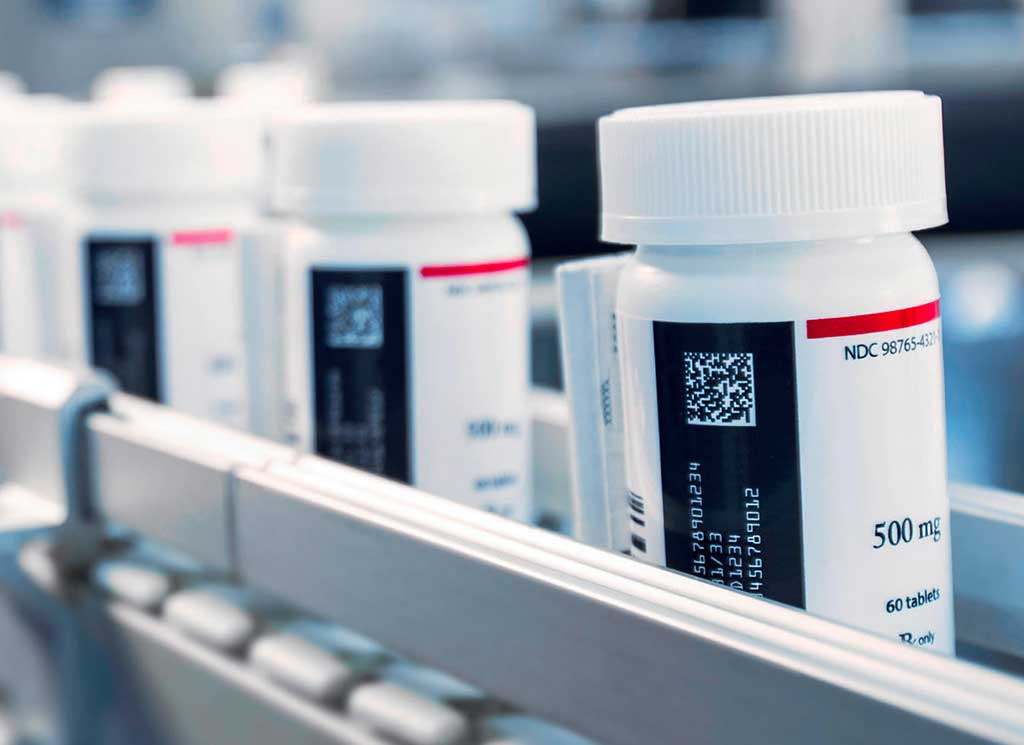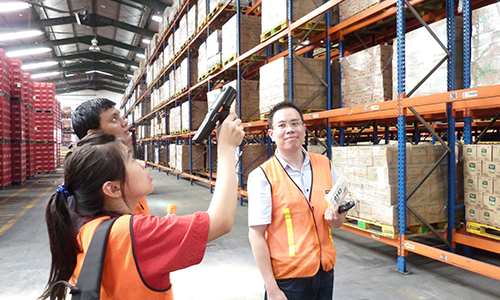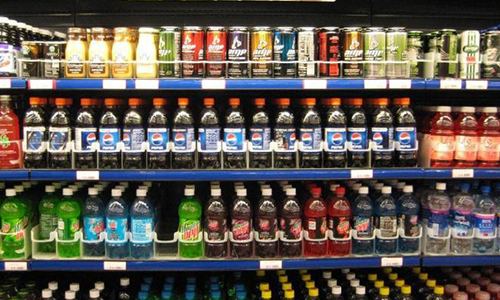Panduan Implementasi 2D Barcode (Serialisasi) Untuk Distributor Farmasi
[vc_row row_scroll_icon="no"][vc_column][vc_empty_space height="24px"][vc_column_text css=""] Inisiatif 2D Barcode Farmasi Berdasarkan Peraturan Badan Pengawasan Obat dan Makanan (BPOM) nomor 22 tahun 2022 mengenai keamanan dan proteksi obat dan makanan, setiap produk yang masuk dalam kategori tertentu harus mengadopsi pemakaian 2D Barcode unik (serial) yang dapat digunakan untuk penelusuran sampai ke asal dan pembuatan produknya. Inisiatif ini diintensifkan setelah kejadian yang tidak diinginkan karena obat-obatan yang mengandung bahan terlarang. Kategori produk yang wajib mengimplementasikan hal ini: Obat Obat tradisional Obat kuasi Suplemen kesehatan, dan Pangan olahan Seluruh pabrikan dan mata rantai distribusi kategori-kategori produk tersebut harus segera mengadopsi pemakaian 2D Barcode selambat-lambatnya tahun 2027 berdasarkan fase implementasi sebagai berikut:[/vc_column_text][vc_empty_space height="24px"][vc_row_inner][vc_column_inner width="2/3"][vc_single_image image="6177" img_size="full" alignment="center" css=""][/vc_column_inner][vc_column_inner width="1/3"][vc_video link="https://www.youtube.com/watch?v=32qBWxBDw9c" align="center" css=""][vc_empty_space][vc_video link="https://www.youtube.com/watch?v=K_wyhPf6_FM" align="center" css=""][/vc_column_inner][/vc_row_inner][vc_empty_space][vc_column_text css=""] Proses Distribusi Dengan 2D Barcode [/vc_column_text][vc_empty_space][vc_single_image image="6182" img_size="full" alignment="center" css=""][vc_empty_space height="24px"][vc_column_text css=""]Apabila produk, misalnya obat, yang telah terdaftar di BPOM tentunya sudah mempunyai NIE (Nomor Ijin Edar) sehingga untuk setiap obat yang diproduksi telah dapat langsung didaftarkan 2D Barcode-nya ke BPOM (Poin 1). Seluruh produk yang telah didaftarkan 2D Barcode-nya tentunya sudah dapat dikirimkan melalui kanal distribusi (PBF) hingga ke Faskes di Rumah Sakit dan ke konsumen (Ritel atau Apotik). Dalam jalur distribusi ini, setiap produk yang masuk maupun keluar di setiap titik harus melaporkan semua 2D Barcode via TTAC BPOM (Poin 2 & 3). Proses ini amat sangat terbantu bila sudah mempunyai aplikasi WMS atau Warehouse Management System yang dapat mempersimpel proses pelaporan ini. Banyak keuntungan dari penggunaan WMS ini yang akan dijelaskan lebih detail di bagian berikutnya. Bila seluruh jaringan distribusi telah menjalankan pelaporan 2D Barcode dengan baik, tentunya adalah hal yang baik bagi konsumen karena lebih yakin dengan keamanan dan legalitas obat maupun makanan yang dikonsumsi dengan cara mengecek melalui aplikasi BPOM Mobile saja (Poin 4).[/vc_column_text][vc_empty_space][vc_column_text css=""] Integrasi Largo WMS Dengan Inisiatif Serialisasi BPOM Integrasi antara Largo WMS dengan proses distribusi berdasarkan 2D Barcode (Serialisasi) akan menciptakan sinergi terbaik dalam beberapa hal: Manajemen Serialisasi Otomatis WMS dapat secara otomatis menangkap dan merekam data serialisasi selama proses penerimaan, penyimpanan, pemilihan, dan pengiriman. Ini memastikan bahwa informasi serialisasi dilacak dan dipertahankan dengan akurat sepanjang siklus distribusi produk. Visibilitas Real-Time Kombinasi WMS dan serialisasi memberikan visibilitas real-time ke dalam level inventaris, lokasi, dan pergerakan. Visibilitas ini sangat penting untuk mengelola produk yang diserialisasi, memastikan bahwa setiap unit tercatat dan dapat dilacak setiap saat. Peningkatan Kepatuhan Sistem terintegrasi membantu memenuhi persyaratan regulasi BPOM dengan mempertahankan catatan rinci tentang produk yang diserialisasi, termasuk pergerakan, kondisi penyimpanan, dan penanganannya. Ini memastikan kepatuhan terhadap regulasi seperti Undang-Undang Keamanan Rantai Pasokan Obat (DSCSA) di Amerika Serikat. Peningkatan...
Streamlining Packing Process in the Warehouse
[vc_row row_scroll_icon="no"][vc_column][vc_empty_space height="24px"][vc_column_text css=""]PS: Bahasa Indonesia version of this article available below[/vc_column_text][vc_empty_space height="24px"][vc_column_text css=""]If your business is one of these: E-Commerce Fulfillment Provider Multi-chain Retail Store Automotive Spare parts Distributor Pharmaceutical Distribution Most probably you will need to pack for a lot of shipment orders to end consumers, to branch stores, resellers or retailers. Everything has to be done accurately and swiftly in order to ship out hundreds if not thousands of packages every single day with minimum mistakes. You may already have packing stations or simply a packing area for the packing operators to run through the many items dropped by pickers in the warehouse. Most importantly is how to run it efficiently, effectively, accurately and recorded in real-time. That is just where Largo WMS excels in. Aside from the usual inbound to outbound process automation, Largo WMS also has Packing feature that is integrated with the warehouse flow. The feature is available in both desktop as well as mobile mode. The desktop mode is web-based intuitive interface that can be operated on the packing station and the mobile mode is for used with Android-based rugged device for doing packing operation anywhere as needed. It is flexible enough to be used on any packing environment.[/vc_column_text][vc_single_image image="6157" img_size="full" css=""][vc_column_text css=""]Here are some of Largo WMS Packing features: Multi-tote / multi-tray support -- Segregating items per order since picking process to make packing process easier Packaging counting -- Increase visibility on frequently used packagings so you may stock properly Barcode scanning and printing integration -- Single source of data to check when confirming items to be packed and print suitable packing label Multi packing support -- Current packaging is fully filled out but more items to pack for the same order? Add more packaging with one click Unpack Item -- Take out those the wrong items easily without having to cancel the whole order Label void -- Need to cancel the whole order? Easy with one-click operation Intuitive UI/UX -- Minimum typing and maximize scanning operation instead [/vc_column_text][vc_column_text css=""] The benefits? Easy to operate as everything is already system-guided Less packing error allow for lower costly returns that leads to higher customer satisfaction Save more on the packaging items (carton boxes or any container) by minimizing the stock Effective warehouse operation = happy customer Want to know more? Just click below buttons to let us know or simply to check out our website beforehand.[/vc_column_text][vc_empty_space][vc_row_inner][vc_column_inner width="1/3"][eltd_button size="medium" type="solid" hover_type=""...
Penggunaan Barcode di Gudang (Warehouse / Distribution Center)
[vc_row row_scroll_icon="no"][vc_column][vc_empty_space][vc_column_text] Link: Mengapa Butuh Barcode di Gudang? Aplikasi WMS untuk Gudang Apa Yang Harus Dipersiapkan Untuk Menggunakan WMS? Butuh Konsultasi / Presentasi? [/vc_column_text][eltd_separator type="full-width"][/vc_column][/vc_row][vc_row row_scroll_icon="no" el_id="1"][vc_column][vc_empty_space][eltd_section_title title="Mengapa Butuh Barcode di Gudang?" title_color="" title_text_transform="" title_text_align="" margin_bottom="" title_size="small"][vc_empty_space height="20px"][vc_column_text] Penggunaan barcode di sudah biasa kita temukan di produk-produk yang setiap hari kita gunakan, dari alat-alat rumah tangga, makanan, minuman sampai ke alat-alat industri. Bentuk barcode-nya juga bisa berupa barcode 1D (1 dimensi) yang berupa garis-garis maupun berbentuk barcode 2D (2 dimensi) seperti QR-code yang paling umum. Meskipun produk/barang sudah mempunyai barcode bawaan, tetapi belum tentu dapat digunakan di area Gudang. Fungsi gudang seperti Gudang Bahan Baku Produksi, Gudang Barang Jadi Produksi, Gudang Distribusi (Distribution Center), dan Gudang Logistik biasanya membutuhkan pemakaian Barcode yang khusus untuk gudang. Ingin tahu lebih jauh lagi mengenai Barcode Gudang dan bedanya dengan Barcode produk? Silahkan disimak video berikut ini: [/vc_column_text][vc_empty_space][vc_video link="https://youtu.be/JBafOxSlL7I" align="center" css=""][vc_empty_space][eltd_separator type="full-width"][/vc_column][/vc_row][vc_row row_scroll_icon="no" el_id="2"][vc_column][vc_empty_space][eltd_section_title title="Aplikasi WMS Untuk Gudang" title_color="" title_text_transform="" title_text_align="" margin_bottom="" title_size="small"][vc_empty_space height="20px"][vc_column_text] Barcode Gudang (atau Barcode LPN) biasanya dapat dicetak sendiri secara manual maupun secara otomatis dari sistem WMS (Warehouse Management System). Kami menyarankan penggunaan sistem aplikasi WMS karena pencatatan berdasarkan Barcode Gudang yang sudah tercatat secara digital yang akan membantu meminimalisir kesalahan manusia (human error) secara signifikan. Pertanyaannya adalah: Kapan saatnya mulai menggunakan WMS? Dalam hal ini ada beberapa point indikasi perusahaan Anda sudah membutuhkan aplikasi WMS: Perlu mencatat Batch, Lot dan/atau Expired Date serta memanfaatkan informasi tsb untuk pengeluaran barang berdasarkan FIFO/FEFO dan Shelf Life Kesulitan mengetahui dengan pasti untuk stok barang-barang yang terlanjur ataupun hampir kadaluarsa Sering terjadi kesalahan pengiriman barang, baik salah barang maupun salah tujuan Persiapan yang panjang setiap kalinya untuk melakukan stock opname dan itupun hasilnya kurang akurat setiap kalinya Tidak mengetahui performa atau produktivitas operator Gudang secara lebih pasti Silahkan simak video paparan lengkap mengenai isu-isu di atas untuk Anda yang ingin tahu lebih detail: [/vc_column_text][vc_empty_space][vc_video link="https://youtu.be/ell_5wk_XTQ" align="center" css=""][vc_empty_space][eltd_separator type="full-width"][/vc_column][/vc_row][vc_row row_scroll_icon="no" el_id="3"][vc_column][vc_empty_space][eltd_section_title title="Apa Yang Harus Dipersiapkan Untuk Menggunakan WMS?" title_color="" title_text_transform="" title_text_align="" margin_bottom="" title_size="small"][vc_empty_space height="20px"][vc_column_text] Largo WMS telah digunakan oleh perusahaan-perusahaan ternama nasional dan terbukti efektif menjawab isu-isu di atas yang memang umum terjadi di Gudang. Untuk dapat meng-implementasikan Largo WMS, Anda perlu mempersiapkan beberapa hal sebagai berikut: [/vc_column_text][vc_empty_space][vc_column_text] 1. Rugged Mobile Computer dan Barcode Printer [/vc_column_text][vc_row_inner content_aligment="center" css=".vc_custom_1649054511791{padding-top: 10px !important;padding-right: 10px !important;padding-bottom: 10px !important;padding-left: 50px !important;}"][vc_column_inner width="2/3"][vc_column_text] Yang paling utama, Anda akan membutuhkan Barcode Printer (pencetak label barcode) dan Rugged Mobile Computer (Barcode Scanner dgn OS Android). Kami merekomendasikan penggunaan produk dari Zebra Technologies karena memang didesain dan sudah teruji untuk...
How long to implement a WMS System?
[vc_row row_scroll_icon="no"][vc_column][vc_empty_space height="24px"][vc_column_text]Implementing warehouse management system requires several steps to ensure its success. It's not just the system as the system usually is ready to be deployed within days. The other requirement however, requires more time to prepare. Let's break it down. Gap Development The first step of WMS implementation is to get a gap analysis between LARGO and your existing business process. We need to make sure everything is covered and ensure the flow from start to finish. This process usually involves warehouse team, finance, IT, ERP consultant and management. This step usually take around 2 - 8 weeks to complete. Hardware Purchase We also need several hardware to support WMS project such as Server, Wireless Network, Mobile Computers and Barcode Printers. Some of these thing requires 8 - 10 weeks to purchase and install, so please be prepare to factor in these into your timeline. Integration, Data Migration and Data Sanitation IF you need to connect WMS with your ERP or eCommerce system, then we will need to have an integration work together with your ERP consultant. This job including Blue Print / design, development, testing and go live. We also need to migrate some data from your existing system, such as master files, tables, etc. Sometimes, existing data also requires a sanitation process to remove unwanted/unused data. This process can take up to 4 - 8 weeks as well. Warehouse Preparation Items in the warehouse needs to be re-labeled and re-registered to the new system. Each bin location also must be labeled. Depending on the number of stock in the warehouse, this process can take up to 4 - 8 weeks as well. Training Once everything is ready, we need to train every stakeholders in the company which can take up to 1 week for both classroom training and field training. After the training, we take the system to Go Live! So the conclusion, to implement LARGO Warehouse Management System, we needs around 2 - 4 months to complete. Contact our team to discuss more on the timeline and what are the thing you need to prepare before implementing WMS.[/vc_column_text][/vc_column][/vc_row]...
Choosing the Right Mobile Computer for WMS
[vc_row row_scroll_icon="no"][vc_column][vc_empty_space height="24px"][vc_column_text]Mobile Computer or some call it PDT, HHT, RF, Handheld...
Existing Barcode vs New Barcode
[vc_row row_scroll_icon="no"][vc_column][vc_empty_space height="24px"][vc_column_text]We often come across question from our client "Can we use our existing barcode on the product in the warehouse" ? Well, the simple rule in the warehouse is that we need a UNIQUE barcode for each unit of measurement which can be a carton or a pallet. This unique barcode will help us to identify individual FIFO, expiry date, batch, production number and other important information. Product barcode is usually NOT UNIQUE. It means, for every Coca-Cola can, the barcode will all be the same. And don't forget that this barcode lays on item level, which is rarely the case for warehouse operation. That's why, when a product comes in to the warehouse, during Tally process, we put a new unique barcode for each carton or pallet. The barcode then will be associated with information required so now every carton or pallet has a unique information attached to its barcode. This information will continue being updated along the way during every warehouse operation such as put away, picking, stock take and delivery. If you have a unique case or need to discuss how to use barcode in your warehouse, let us know and we will be very happy to help.[/vc_column_text][/vc_column][/vc_row]...








